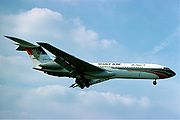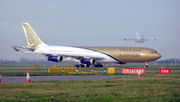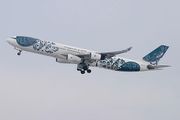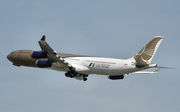Gulf Air
 |
||||
|
||||
| Founded | 1950 | |||
|---|---|---|---|---|
| Hubs | Bahrain International Airport | |||
| Frequent-flyer program | Gulf Air Frequent Flyer Programme | |||
| Member lounge | Falcon Gold Lounge | |||
| Fleet size | 33 (+64 orders) | |||
| Destinations | 45 | |||
| Company slogan | Guaranteed To Make You Smile | |||
| Headquarters | Muharraq, Bahrain | |||
| Key people |
|
|||
| Website | www.gulfair.com | |||
Gulf Air (Arabic: طيران الخليج Ṭayarān al-Khalīj) is the principal flag carrier of the Kingdom of Bahrain. Headquartered in Muharraq,[1] adjacent to Bahrain International Airport,[2] the airline operates scheduled services to 45 destinations in 28 countries across Africa, Asia and Europe. Its main base is Bahrain International Airport.[3] and major destinations include London, Paris, Dubai and Mumbai.
The airline is part of the Oneworld global explorer fare. It has extensive codeshare agreements with other airlines and special partnerships with Jet Airways and Oman Air's Frequent Flyer Programs.
Contents |
History
1940–1992: A booming and new beginning
In the late 1940s, Freddie Bosworth, a British pilot and entrepreneur, began an air taxi service to Doha and Dhahran from Bahrain. Bosworth later expanded service and, in 1950, registered Gulf Aviation as a private shareholding company, making it one of the oldest carriers in the Middle East.[4] The fleet contained seven Avro Ansons and three De Havilland DH.86B 4-engine biplanes.
In October 1951, British Overseas Airways Corporation (BOAC) became a major shareholder in Gulf Aviation, holding a 22% stake.[3]
In 1973 the governments of the Kingdom of Bahrain, State of Qatar, the Emirate of Abu Dhabi, and the Sultanate of Oman purchased BOAC's shares in Gulf Aviation. The Foundation Treaty signed on 1 January 1974 gave each government a 25% shareholding in the rebranded Gulf Air, which became the national carrier for the four states. Later that year, the airline's support of oil exploration resulted in the establishment of the wholly owned Gulf Helicopters subsidiary.[3]

With leased Lockheed L-1011 Tristar and Boeing 737 aircraft joining the fleet, by 1976, Gulf Air had expanded its route network to include Amman, Amsterdam, Athens, Baghdad, Bangkok, Beirut, Cairo, Colombo, Delhi, Dhaka, Hong Kong, Jeddah, Khartoum, Larnaca, Manila, Paris, Ras al-Khaimah and San‘a’. The fleet comprised four Vickers VC10, three BAC One-Elevens, two Lockheed L-1011 Tristar 200s, and five Boeing 737-200s. Two years later, the airline doubled the Tristar fleet by replacing the VC10s. Meanwhile, the airline increased the Boeing 737 fleet to nine and phased out the One-Elevens.
The 1980s saw an increase in air travel and growth for Gulf Air. In 1981 Gulf Air became an IATA member and in the following year became the first international airline to land at Riyadh. In 1988 the Boeing 767s joined the fleet and the airline launched service to Frankfurt, Istanbul, Damascus, Dar es Salaam, Fujairah, and Nairobi, and resumed service to Shiraz, and Baghdad.
Gulf Air celebrated its 40th anniversary in 1990. The light blue and peach Balenciaga-designed uniform was introduced. Singapore, Sydney, and Thiruvananthapuram were launched and Gulf Air became the first Arab airline to fly to Australia. Gulf Air added service to Johannesburg and Melbourne in 1992, becoming the first Arab airline to fly directly to these cities. In 1993, it opened up a flight simulator centre in Qatar, and introduced service to Casablanca, Entebbe, Jakarta, Kilimanjaro, Madras, Rome, San'a', Zanzibar, and Zürich.
1993–2005: New livery & destinations

In May 1994, Gulf Air received its first Airbus A340-300. Gulf Air introduced a no-smoking policy on flights to Singapore and Australia in 1998, which the airline later extended through its whole network. In 1999, Gulf Air launched three new routes in northern Pakistan—Islamabad, Lahore, and Peshawar. It also took delivery of two out of six Airbus A330-200 aircraft, and introduced a new Balmain uniform.
In 2000 the airline celebrated its 50th anniversary. It took delivery of the remaining Airbus A330-200 aircraft in June of that year, and launched service to Milan. In May 2002, James Hogan became President and CEO of Gulf Air and instigated a three-year restructuring and turnaround programme, which was launched in response to a drastic fall in profits at the company and increasing debt. The Gulf Air board unanimously approved the three-year recovery plan at the extraordinary general meeting held on 18 December. That month, the State of Qatar withdrew from Gulf Air. In 2003 Gulf Air introduced a new Landor Associates designed livery. 1 June 2003 saw the establishment of Gulf Traveller, a subsidiary all-economy full-service airline. Gulf Air also announced a sponsorship deal for the Bahrain Grand Prix through 2010, creating the Gulfair Bahrain Grand Prix, of which the first was staged in 2004. Gulf Air also introduced direct daily flights to Athens and Sydney, via Singapore on 23 November 2003.

In 2004, Gulf Air introduced direct flights between Dubai and London and Muscat and London, and a daily service between Abu Dhabi and Ras Al Khaimah and carried a record 7.5 million passengers during this year. Gulf Air's sponsorship of the Bahrain Formula 1 Grand Prix continued, with a record race crowd and a global TV audience. The airline announced a return to profit, with the best financial performance since 1997. Despite a BD30 million (US$80 million) cost to the business through fuel price rises during the year, Gulf Air recorded a profit of BD1.5 million (US$4.0 million) in the calendar year to December 2004, on revenues up 23.8% to BD476.3 million (US$1.26 billion) (2003: BD 384.6 million / USD1,020.2 million). The results meant the airline out-performed the targets set under Project Falcon, the three-year restructuring plan approved by the Board in December 2002.
The owner states of Gulf Air at that time—the Kingdom of Bahrain, the Emirate of Abu Dhabi, and the Sultanate of Oman—confirmed their support for further expansion of the airline through a new three-year strategic plan which would include re-equipment of the aircraft fleet and recapitalization of the business through private sector financing. Gulf Air was also placed on the IOSA registry following its successful completion of the IATA Operational Safety Audit (IOSA).
2006–2008: Bahrain takes over

The new summer schedule commencing 28 April 2006 saw the complete withdrawal of Abu Dhabi as a hub following the decision on the 13 September 2005 by the Emirate of Abu Dhabi to withdraw from Gulf Air and establish its own airline, Etihad Airways.[4] Gulf Air changed its operations to a dual hub basis between Bahrain and Muscat airports. The airline produced a series of adverts in local newspapers thanking Abu Dhabi for its contribution to Gulf Air. Due to the airline being the national carrier for the United Arab Emirates for over 35 years, it has a large customer base located in Abu Dhabi. Gulf Air endeavoured to show the continuing support for flights to Abu Dhabi from Bahrain and Muscat, connecting to the rest of the Gulf Air network, via advertisements placed in local newspapers.
Gulf Air has an aircraft simulator facility at its Bahrain Headquarters. The BD5.5 million facility will offer real-time, simulated on-board training to pilots in three flight simulators.
On 27 April 2006, the governments of Bahrain and Thailand signed an Open Skies agreement which allowed an unlimited and unrestricted number of flights between the two nations. Gulf Air operates daily flights to Bangkok from Bahrain, with four flights a week from Muscat. With this new agreement in place, Gulf Air doubled its frequency to Thailand in July 2006, with 14 flights a week between Bahrain and Thailand.

James Hogan resigned as President and Chief Executive Officer as of 1 October 2006 and has since taken the position of CEO at rival airline Etihad. Ahmed Al Hammadi was named acting chief executive officer until Swiss national André Dosé, the former chief executive officer of Crossair and Swiss International Air Lines, began on 1 April 2007. A few days later, Dosé announced a BD310 million (USD825 million) restructuring plan that included originating or terminating all flights in Bahrain, ceasing routes to Johannesburg, Dublin, Jakarta, Singapore, Hong Kong and Sydney; eliminating nine Boeing 767s from the fleet, phasing out the Airbus A340-300 from the fleet, introducing the Airbus A321 in July 2007 and the Airbus A330-300 in 2009, and terminating employees based on performance and without regard for nationality. This led to some employees applying for jobs in other airlines and, in less than a month, Gulf Air lost 500 persons from its workforce, prompting the airline to rule out mass layoffs as part of its recovery plan, except for performance reasons. The airline is aiming at cutting its workforce by 25 percent through people leaving naturally or accepting voluntary early retirement packages, and the company has a recruitment freeze.
On 6 May 2007, the government of Bahrain claimed full ownership of the airline as joint-owner Oman withdrew from the airline. André Dosé resigned on 23 July 2007 and was replaced by Bjorn Naf. On 6 November 2007, Gulf Air started its third daily nonstop flight to London Heathrow Airport from Bahrain. On the same day, Gulf Air became fully owned by Bahrain.
The airline inaugurated services to Shanghai Pudong International Airport on 16 June 2008 and has placed orders with Boeing (for 24 B787s) and Airbus (for 15 A320s and 20 A330s) to upgrade its fleet.
The airline's last commercial Boeing 767 flight was on 29 May 2008 and the aircraft was flown to Dublin on 30 May 2008; two of the Boeing 767 aircraft are now in storage at Bournemouth Airport.
On 3 July 2008, Gulf Air was announced as the official sponsor of upcoming English football club, Queens Park Rangers.
Gulf Air signed, in 2008, a lease agreement for five aircraft with International Lease Finance Corporation (ILFC) as part of the airline's growth and expansion strategy. The lease is for six years for two Airbus A319-100, delivered in September 2008, and three Airbus A330-200, due for delivery in March, April and May 2009.
2009–present: Change in the airline, new CEO
In March 2009, Gulf Air signed a 42-month lease agreement with Jet Airways for four Boeing B777-300ER aircraft. The first six months of the term were for a wet-lease arrangement, Jet Airways pilots with Gulf Air cabin crew, to be followed by a 36-month dry-lease, all Gulf Air crew. However, the dry-lease portion of the agreement was cancelled in May 2009 and the aircraft were returned to Jet Airways starting in September 2009.
Gulf Air announced in March 2009 the suspension of service to three Indian destinations that month—Bangalore, Hyderabad, and Kolkata. Service to Bangalore and Hyderbad has since resumed.
In May 2009, Gulf Air inaugurated summer seasonal flights to Alexandria, Aleppo, and Salalah.
Starting June 2009, Gulf Air's Golden Falcon logo will be on the streets of London, emblazoned on the side of the city's taxi cabs, as part a two-year marketing deal. Fifty Hackney Carriages will be rolled out in full Gulf Air livery to promote the airline's flights from London Heathrow to Bahrain and beyond.[5]
On 15 June 2009 at the Paris Air Show, Gulf Air selected the Rolls-Royce Trent 700EP engine to power an additional 20 Airbus A330s that it is to start receiving in 2012. Rolls-Royce will provide 44 Trent 700EPs, including four spares, to the airline, which already has Trents on its 10 A330-200s in service.[6]
In late June 2009 Gulf Air announced the departure of CEO Bjorn Naf and the appointment of Samer Majali (who worked previously for Royal Jordanian) as CEO effective 1 August 2009.
On 1 September 2009, Gulf Air resumed flights to Baghdad.[7] Service to Najaf will begin 26 September and Erbil will begin on 26 October.
Gulf Air is planning to sell five of their Airbus A340-300 and lease the other four.[8][9] Two have already been sold for spare parts, registrations A9C-LC and -LB. A9C-LC has had its tail logo and title removed.
On 1 March 2010, Gulf Air launched its new "Falcon Gold" cabin, a single premium cabin that is aimed at offering higher standards of comfort for the usual price. Temporarily, the same seats will be used until a new-state-of-the-art flat bed seat is launched soon.
Destinations
Gulf Air flies to 45 international destinations in 28 countries across Africa, Asia and Europe from its hub at Bahrain International Airport.[10]
Gulf Air has codeshare agreements with the following airlines:
|
|
Fleet
Gulf Air has operated many aircraft over the years. These include Boeing 737, Boeing 747, Boeing 757, Boeing 767, Boeing 777 and the Lockheed L-1011 TriStar. Currently, the Gulf Air fleet consists of the following aircraft (as of 15 July 2010):[12]
| Aircraft | In Fleet | Orders | Passengers (Business/Economy) |
Notes |
|---|---|---|---|---|
| Airbus A319-112 | 2 | 0 | 124 (16/108) | |
| Airbus A320-212 | 3 | 0 | 136 (16/120) | |
| Airbus A320-214 | 9 | 15 | 136 (16/120) | |
| Airbus A321-211 | 2 | 0 | 170 (20/150) | |
| Airbus A330-243 | 10 | 0 | 215 (32/183) | |
| Airbus A330-300 | 0 | 20 | TBA | Entry into service: 2012 |
| Airbus A340-312 | 2 | 0 | 268 (32/207) | |
| Airbus A340-313X | 4 | 0 | 268 (32/207) | |
| Boeing 787-8 | 0 | 24 | TBA | Entry into service: 2016 |
| Embraer 170LR | 2 | 0 | 67 (7/60) | |
| Total | 33 | 60 |
Subsidiaries
Gulf Traveller
"Gulf Traveller" was the all-economy full service subsidiary airline of Gulf Air. Its main base was Abu Dhabi International Airport.[3] It was briefly relocated between Bahrain and Muscat airports after Abu Dhabi pulled out of the Gulf Air consortium in 2005, and in May 2007 Oman also pulled out of the group leaving Bahrain as sole owner of Gulf Air. Gulf Traveller has since been disbanded due to these changes.
Sponsorship
Gulf Air sponsors events, of which the most prestigious is the Bahrain Grand Prix. This is usually the third race of the Formula One season and is held in March or April of each year. They have also recently become sponsors of the English football Championship side Queens Park Rangers F.C. Gulf Air also signed a sponsorship with the Oman national football team in 2006.
Incidents and accidents
-
- 23 Sep 1983: Gulf Air Flight 771 was a flight from Karachi, Pakistan to Qatar via Abu Dhabi, United Arab Emirates. On 23 September 1983, while the Boeing 737-2P6[13] was on approach to Abu Dhabi International Airport, a bomb exploded in the baggage compartment. The plane crashed in the desert near Mina Jebel Ali between Abu Dhabi and Dubai in the UAE. All seven crew members and 105 passengers died. Most of the dead passengers were Pakistani nationals, many returning to jobs in the Gulf after spending the Eid ul-Adha holiday with their families in Pakistan.[14]. The bomb was apparently planted by the Abu Nidal organization, to convince the Gulf States to pay protection money to Nidal so as to avoid attacks on their soil.[15] It was rumoured that Kuwait and the United Arab Emirates paid the money soon after the bombing.
-
- 23 Aug 2000: Gulf Air Flight 072 crashed into the Persian Gulf on approach to Bahrain International Airport from Cairo. The A320 with 143 passengers and crew on board approached the landing at higher speeds than normal and carried out an unusual low altitude orbit in an attempt to correct the approach.[16][17] The orbit was unsuccessful and a go-around was attempted. While carrying out a turning climb the aircraft entered a descent at 15 degrees nose down. The aircrew did not respond to repeated GPWS warnings[18] and approximately one minute after starting the go-around the aircraft disappeared from radar screens.[19] There were no survivors. 36 children were on the aircraft [1]. The accident investigation concluded that the primary cause of the crash was pilot error (including spatial disorientation), with a secondary factor being systemic organizational and oversight issues.[20] Flight 072 was the highest death toll of any accident involving an Airbus A320 at that time. It was subsequently surpassed by TAM Airlines Flight 3054, which crashed on 17 July 2007 with 199 fatalities.
References
- References
- ↑ Summers, Mark. "'It's business as usual' at Gulf Air." Gulf Daily News. Wednesday 25 July 2007. Retrieved on 24 September 2009.
- ↑ "Airline Membership". IATA. http://www.iata.org/membership/Pages/airline_members_list.aspx?All=true.
- ↑ 3.0 3.1 3.2 3.3 Flight International 3 April 2007
- ↑ 4.0 4.1 "Gulf Air adds new routes to China and India; increasing capacity to Europe this winter". anna.aero. 03/10/08. http://www.anna.aero/2008/10/03/gulf-air-adds-new-routes-to-china-and-india/.
- ↑ Sambidge, Andy (2/6/09). "Gulf Air signs two-year London taxis marketing deal". Arabian Business. http://www.arabianbusiness.com/557464-gulf-air-signs-two-year-london-taxis-marketing-deal. Retrieved 15 July 2010.
- ↑ Daly, Kieran (15/06/09). "PARIS AIR SHOW: Gulf Air hands Rolls-Royce big order to power A330s". Flight Global. http://www.flightglobal.com/articles/2009/06/15/328065/paris-air-show-gulf-air-hands-rolls-royce-big-order-to-power.html. Retrieved 15 July 2010.
- ↑ "Gulf Air adds three Iraqi cities". AMEInfo.com. 6/8/09. http://www.ameinfo.com/205799.html. Retrieved 15 July 2010.
- ↑ http://blog.seattlepi.com/worldairlinenews/archives/178076.asp?from=blog_last3
- ↑ Kaminski-Morrow, David (01/09/09). "Gulf Air puts A340 fleet on the market". Flight Global. http://www.flightglobal.com/articles/2009/09/01/331725/gulf-air-puts-a340-fleet-on-the-market.html. Retrieved 15 July 2010.
- ↑ "Gulf Air Destinations Map". Gulf Air. http://www.gulfair.com/English/PlanandBook/Pages/InteractiveMap.aspx.
- ↑ "Jet Airways enters into code share agreement with Gulf Air". India Infoline Limited. 1/4/10. http://www.indiainfoline.com/Markets/News/Jet-Airways-enters-into-code-share-agreement-with-Gulf-Air/4807834724. Retrieved 17 July 2010.
- ↑ "Gulf Air Fleet". CH-Aviation. http://www.ch-aviation.ch/aircraft.php?search=set&airline=GF&al_op=1.
- ↑ "Accident Database". AirDisaster.Com. http://www.airdisaster.com/cgi-bin/view_details.cgi?date=09231983®=A40-BK&airline=Gulf+Air. Retrieved 15 July 2010.
- ↑ The Gulf Times, Qatar, (24 September 1983)
- ↑ -> News -> World -> Abu Nidal behind 1983 Gulf Air bombing: Aide
- ↑ "Airbus A320 A40-EK accident record". Aviation Safety Network. http://aviation-safety.net/database/record.php?id=20000823-0&lang=en. "..significantly higher than standard aircraft speeds during the descent and the first approach... ...performing an orbit, a non-standard manoeuvre, close to the runway at low altitude".."
- ↑ "ACCIDENT INVESTIGATION REPORT Gulf Air Flight GF-072". Civil Aviation Authority of Bahrain. http://web.archive.org/web/20040212231659/http://www.bahrainairport.com/caa/gf072.html.
- ↑ "ACCIDENT INVESTIGATION REPORT Gulf Air Flight GF-072". Civil Aviation Authority of Bahrain. http://web.archive.org/web/*/http://www.bahrainairport.com/caa/gf072/pdf/conclusions.pdf. "4b. The analysis of FDR and CVR recordings indicated that neither the captain nor the first officer perceived, or effectively responded to, the threat of the aircraft's increasing proximity to the ground in spite of repeated hard GPWS warnings..."
- ↑ "Airbus A320 A4O-EK accident record - Graphic - A40-EK Flight Path dervied from Lat and Long FDR Parameters". Bureau Enquetes-Accidents. Aviation Safety Network. http://aviation-safety.net/photos/displayphoto.php?id=20000823-0&vnr=1&kind=G.
- ↑ "Airbus A320 A4O-EK accident record". Aviation Safety Network. http://aviation-safety.net/database/record.php?id=20000823-0&lang=en. "The investigation showed that no single factor was responsible for the accident to GF-072. The accident was the result of a fatal combination of many contributory factors, both at the individual and systemic levels."
- Bibliography
- Gulf Daily News
- Trade Arabia
- Trade Arabia Business Information and Trade News Portal
- AAK News (in Arabic)
- Gulf Daily News
- Gulf Daily News
- Gulf Daily News
External links
- Official website
- Gulf Air Frequent Flyer
- Gulf Air Careers website
- Gulf Air Cargo website
- Gulf Life inflight magazine
|
||||||||||||||||||||||||||||||||||||||||||||||||||||||||||||||||||
|
|||||